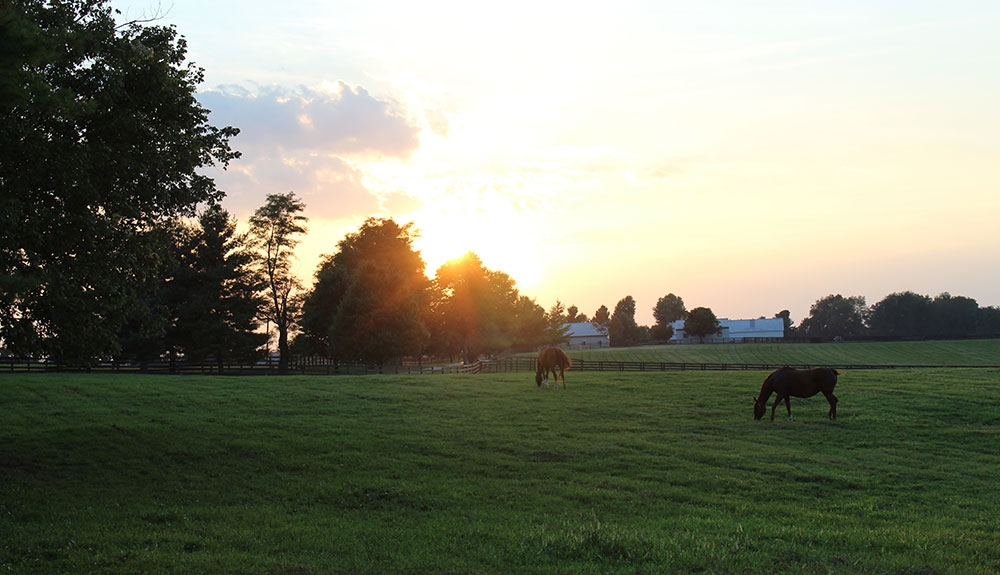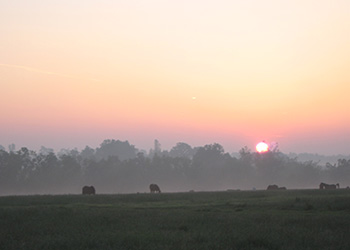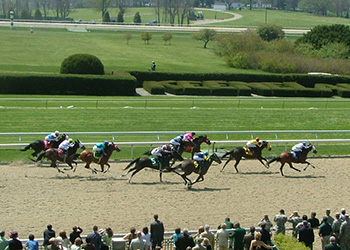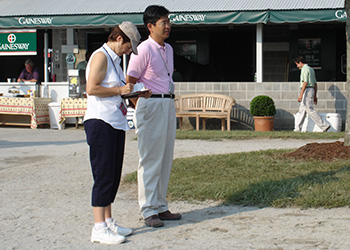Winchester Farm was created in 2002 when Dr. Naoya Yoshida, DVM, and his wife, Marie Yoshida-Debeusscher, purchased a 150-acre farm on Winchester Road adjacent to historic Claiborne Farm in Paris, Kentucky. Dr. and Mrs. Yoshida’s goal was to establish a high-quality Thoroughbred breeding and boarding operation where their international clientele would have access to the top Thoroughbred stallions in the industry. They also planned to expand their American client base by offering various services such as mating consultations, breeding and boarding services, sales preparation, business partnerships and global stallion and racehorse management services.
In just two short years, Winchester Farm had outgrown the property in Paris, and Dr. and Mrs. Yoshida purchased Indian Hill Farm in Lexington. The 270-acre farm was previously owned by top Thoroughbred breeder and sales consignor Lee Eaton, and its history is closely tied to the very beginnings of Lexington.
The farm was originally owned by Charles C. Moore (1789-1860), his wife Maryanne H. Moore and their children, Alice Warren Moore, Mary Moore Brent and Jennie Moore Cantrill, who settled on the property sometime in the early 1800s. These family members, including Jennie’s husband, James E. Cantrill, and Mary’s husband, Major Thomas Y. Brent of the 5th regular Kentucky Cavalry, Confederate States Army, are buried on the farm in a small stone-fenced cemetery in one of the horse paddocks close to what is now the main house.

Resting place of Major Thomas Y. Brent, husband of Mary Moore Brent. 
The small stone-fenced cemetery is the resting place for the original owners of Winchester Farm, the Moore Family. 
Major Thomas Y. Brent
The farm stayed in the Moore family, once being divided by Mary Moore Brent for her two only children, Margaret Brent Atkins and Mary Brent Dabney. It is unclear from Fayette County records how large the farm originally owned by Charles C. Moore was, but the two parcels owned by Mrs. Dabney and her sister Mrs. Atkins were roughly 71 and 79 acres each. Eventually, through marriages and land purchases, the farm grew to be about 270 acres, when it was eventually sold by Edward and Betty Moore to Lee Eaton in 1964. Eaton renamed the farm Indian Hill Farm, for the Adena Indian mound located next to the property along a bend of North Elkhorn Creek.
Under Eaton’s ownership, the farm produced many prominent Thoroughbred horses. Comely Nell, the foundation mare Eaton purchased from Calumet Farm and who was never raced because she was blind in one eye, is buried on the farm. Comely Nell was bred by Lee Eaton to Irish Castle and in 1973 foaled a colt that was raised on the farm before being sold at the Fasig-Tipton Summer Sale. The colt, Bold Forbes, would go on to win the 1976 Kentucky Derby and Belmont Stakes.
Eaton bred Comely Nell again to Irish Castle, this time producing Priceless Fame, who would become the dam of Grade 1 winners Dunbeath and Saratoga Six. Eaton also purchased as a foundation mare Courtly Dee, 1983 Broodmare of the Year and the dam of stakes winners Native Courier, Ali Oop, Princess Oola and the stallion Twining. It was through Courtly Dee, now considered a Thoroughbred matriarch, that the farm produced the Grade 1 stakes winners Azzaam, Green Desert and Market Booster. The farm also produced the champion racehorse and sire Woodman. Eaton eventually sold Indian Hill Farm to Reiley McDonald and his partners in 1999, although it remained the broodmare division of Eaton Farms. In 2004, McDonald and his partners decided to concentrate on the sales division of Eaton Farms, Inc. and sold the 270-acre broodmare division to Dr. and Mrs. Yoshida.
Dr. and Mrs. Yoshida were thrilled to acquire the historic property. In an effort to protect both the history and the natural beauty of the farm, the Yoshidas enlisted the property in the purchase of Development Rights Program supported by the Lexington-Fayette Urban County Government, giving up their right to divide their farm into 40-acre parcels. The PDR program now has nearly 30,000 acres under conservation easement, and Dr. and Mrs. Yoshida hope that more horse farm owners will join in the effort to protect the rural legacy and beauty of the Bluegrass area.

The Adena Culture extended across parts of southern Ohio, western Virginia and central and eastern Kentucky. Drawing reproduced from the booklet “Adena, Woodland Period Moundbuilders of the Bluegrass” by A. Gwynn Henderson and Eric J. Schlarb 
Adena Shamans would have held a ceremony within the earthworks to celebrate the gift of renewed life. This is a drawing depicting what that might have looked like. This is the earthwork that sits adjacent to Winchester Farm on the North Elkhorn Creek in Fayette County, Kentucky. Drawing reproduced from the booklet “Adena, Woodland Period Moundbuilders of the Bluegrass” by A. Gwynn Henderson and Eric J. Schlarb 
Looking into the Adena Indian Mound earthworks enclosure at the University of Kentucky Adena Park
The Mount Horeb Earthworks: The Oldest Structure in the Bluegrass
by Richard W. Jefferies, Ph.D.
Department of Anthropology, University of Kentucky, Lexington, Kentucky
The oldest known structure in the Bluegrass is not an Antebellum house or a pioneer cabin but a prehistoric earthen construction located off Mt. Horeb Pike in northern Fayette County. The circular structure, known as the Mount Horeb Earthwork, was built approximately 2,000 years ago by a group of prehistoric Native Americans that archaeologists call Adena. The Adena name has no Native American significance but comes from the name of the farm in Ohio where the first archaeological site of its kind was excavated more than 100 years ago.
The Adena people lived in the Ohio River Valley from about 500 B.C. to 300 A.D. They obtained most of their food by hunting and collecting wild animals and plants. They were a semi-nomadic people, not living in one location for very long. Because of this, archaeologists have found few traces of their campsites and know little about their daily lives. In contrast to their short-term settlements, Adena people devoted considerable energy toward the construction of their many burial mounds, “sacred” circles and other earthworks. Most were likely used for social and ceremonial purposes. The Mount Horeb area of Fayette County contains a number of Adena mounds and earthworks, of which the Mount Horeb Earthwork is the best preserved.
The Mount Horeb Earthwork was excavated by University of Kentucky archaeologist William D. Webb in 1939. Archaeological investigations revealed that the earthwork consisted of an interior circular area measuring about 105 feet in diameter, surrounded by a ditch 45 feet wide and 8 feet deep. The soil from the ditch was piled to the outside, forming a wall 5 feet high that encircled the ditch and the circular interior area. On the southwest side of the earthwork, the ditch and wall were not constructed, to create an entrance. The entire earthwork is approximately 300 feet in diameter.
Webb’s excavation team found few artifacts, but they did expose a circular pattern of dark stains that mark where wooden posts once stood. The circle of posts was approximately 100 feet in diameter and contained 62 obvious pairs of postholes, along with eight single posts. Individual posts, which were about one foot in diameter, probably formed a continuous wall or screen around the edge of the interior circular area. The purpose of the wall is unknown, but it may have been used to restrict viewing of activities that took place in the interior. Most archaeologists agree that the activities conducted at the Mount Horeb Earthwork were social or community-oriented in nature, but their specific purpose remains unknown.
The Mount Horeb Earthworks is not the only Adena structure in the area. A similar, but smaller, version lies just to the south. An earthen Adena burial mound, known as the Fisher Mound, once stood to the west. The mound was excavated in the 1870s. To the southwest, the much larger Peter Village earthwork encloses about 25 acres. Peter Village was also once surrounded by a wooden stockade containing more than 4,000 posts. Other Adena mounds are located across Elkhorn Creek.
Approximately 50 years ago, the Mount Horeb Earthworks site was purchased through private contributions and eventually given to the University of Kentucky. The university continues to maintain the site so that it will be preserved for future generations to visit and study.









